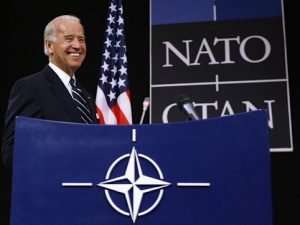
In light of diminishing U.S. support for Ukraine and Donald Trump’s potential return to presidency, European nations and NATO are increasingly concerned about facing Russian aggression alone. Russia’s past actions in Georgia, Ukraine, and Crimea, coupled with its military build-up and Europe’s reduced defense capabilities post-Cold War, have heightened fears. NATO’s readiness is being tested through extensive military exercises, while European leaders contemplate the reality of defending their territories without assured American aid.
 by Janice McAllister
by Janice McAllister
The geopolitical landscape of Europe is facing a seismic shift as the potential for Russian aggression looms larger than ever. With the United States’ wavering support for Ukraine and the rise of Donald Trump, who has previously threatened to withdraw from NATO, European countries are reevaluating their defense strategies. This concern stems from Russia’s historical pattern of territorial expansion and recent military actions, including the 2008 occupation of regions in Georgia, the annexation of Crimea in 2014, and the 2022 invasion of Ukraine.
Europe’s apprehension is not unfounded. Major General Veiko-Vello Palm of the Estonian Army has expressed concerns about NATO’s readiness to confront large-scale operations against Russia. This sentiment is echoed across Europe, particularly in nations bordering or near Russia. These countries have long been wary of Russian intentions, a fear ingrained since the dissolution of the Soviet Union.
NATO’s reduced military capabilities, a consequence of decreased defense spending following the Cold War, add to this anxiety. Despite efforts to bolster defenses, such as the agreement by NATO countries in 2006 to allocate at least 2 percent of their GDP to military spending, progress has been slow. As of the last year, only 11 of the member states have met this target.
The alliance is actively testing its preparedness through Steadfast Defender 2024, a large-scale military exercise involving 90,000 troops, seen as a critical response to potential Russian invasion scenarios. This move indicates a serious shift in NATO’s focus towards collective defense against Russian aggression.
Meanwhile, European leaders are facing the stark reality of potentially defending their lands without the full support of the United States. This situation is exacerbated by the possible return of Donald Trump to the White House, who has shown reluctance in supporting Ukraine and maintaining a strong leadership role in NATO. The uncertainty surrounding U.S. foreign policy has propelled European nations to strengthen their military capacities independently.
Countries like Sweden and Finland, traditionally neutral, are considering NATO membership in response to the escalating threat from Russia. This shift underscores the changing security dynamics in Europe, where the prospect of conflict, once remote, is now a pressing concern.
In conclusion, Europe and NATO are at a crossroads, facing the daunting challenge of a resurgent Russia and the uncertainty of U.S. support. The next few years will be crucial in shaping Europe’s defense landscape and its ability to deter or confront Russian aggression.
(Associated Medias | FAD) – All rights reserved.
